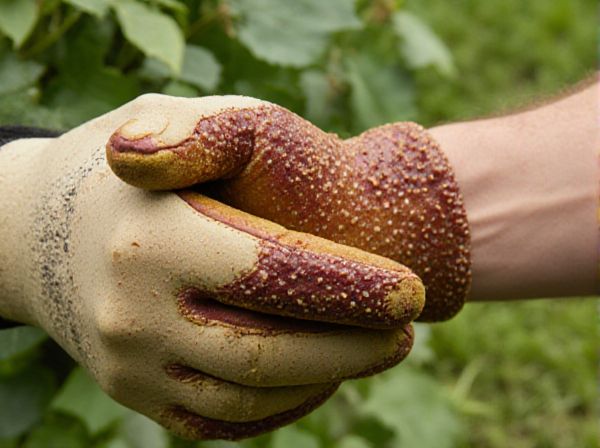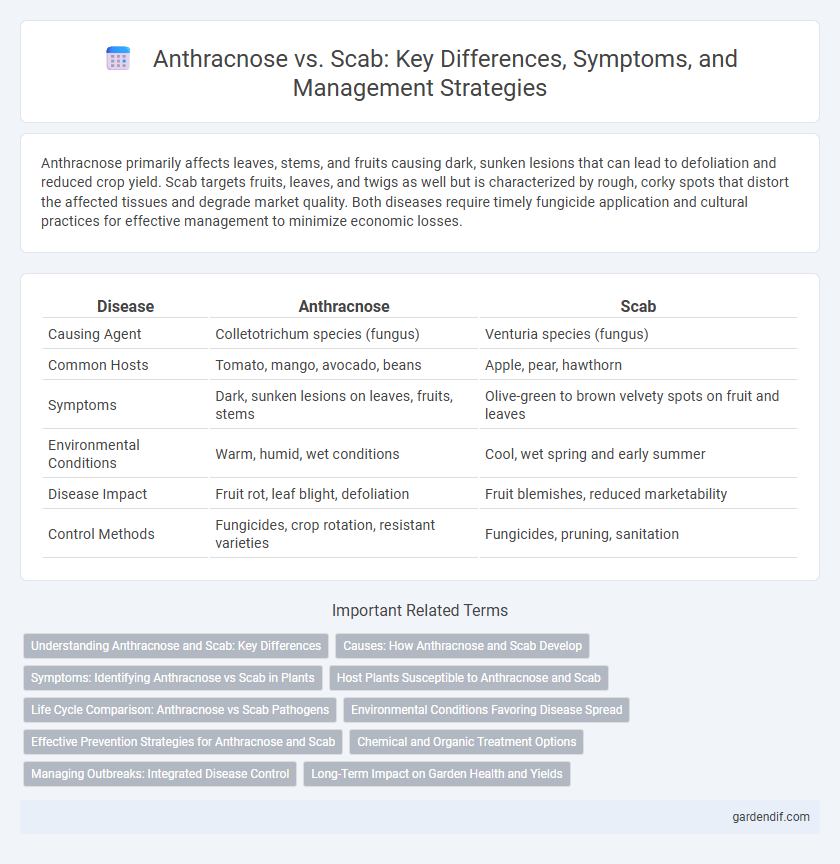
Anthracnose vs Scab Illustration
Anthracnose primarily affects leaves, stems, and fruits causing dark, sunken lesions that can lead to defoliation and reduced crop yield. Scab targets fruits, leaves, and twigs as well but is characterized by rough, corky spots that distort the affected tissues and degrade market quality. Both diseases require timely fungicide application and cultural practices for effective management to minimize economic losses.
Table of Comparison
| Disease | Anthracnose | Scab |
|---|---|---|
| Causing Agent | Colletotrichum species (fungus) | Venturia species (fungus) |
| Common Hosts | Tomato, mango, avocado, beans | Apple, pear, hawthorn |
| Symptoms | Dark, sunken lesions on leaves, fruits, stems | Olive-green to brown velvety spots on fruit and leaves |
| Environmental Conditions | Warm, humid, wet conditions | Cool, wet spring and early summer |
| Disease Impact | Fruit rot, leaf blight, defoliation | Fruit blemishes, reduced marketability |
| Control Methods | Fungicides, crop rotation, resistant varieties | Fungicides, pruning, sanitation |
Understanding Anthracnose and Scab: Key Differences
Anthracnose and scab are fungal diseases affecting various crops, but anthracnose primarily causes dark, sunken lesions on leaves and fruit, while scab produces rough, corky spots mostly on fruit surfaces. Anthracnose fungi, such as Colletotrichum spp., thrive in warm, wet conditions leading to rapid spread, whereas scab is commonly caused by Venturia spp. and favors cooler, humid environments. Effective disease management requires recognizing these environmental preferences and symptom distinctions to implement targeted fungicide treatments and cultural practices.
Causes: How Anthracnose and Scab Develop
Anthracnose develops primarily due to fungal pathogens in the genus Colletotrichum, thriving in warm, wet conditions that promote spore germination and infection on plant tissues. Scab, caused by various fungal species such as Venturia inaequalis in apples, originates from overwintering spores that infect young leaves and fruit during spring under cool, moist environments. Both diseases spread through airborne spores and require specific humidity and temperature ranges to establish and exacerbate infections on host plants.
Symptoms: Identifying Anthracnose vs Scab in Plants
Anthracnose symptoms typically include dark, sunken lesions on leaves, stems, and fruits, often with a target-like appearance, while scab manifests as rough, corky, or raised lesions mainly on fruits and sometimes leaves. Anthracnose leaf spots are usually irregular and may cause leaf curling or blight, whereas scab lesions appear more raised and scabby with a tendency to crack. Identifying these distinct symptom patterns is crucial for accurate disease diagnosis and effective plant disease management.
Host Plants Susceptible to Anthracnose and Scab
Anthracnose primarily affects a broad range of host plants including beans, cucurbits, and hardwood trees, where it causes leaf spots, defoliation, and fruit rot. Scab targets specific crops such as apple, pear, and potato, leading to lesions on fruits, leaves, and tubers that significantly reduce market quality. Understanding host susceptibility to anthracnose and scab is crucial for effective disease management in agricultural and horticultural systems.
Life Cycle Comparison: Anthracnose vs Scab Pathogens
Anthracnose pathogens primarily overwinter in infected plant debris, releasing spores during warm, wet conditions to initiate new infections, while scab pathogens survive on fallen leaves and buds, producing conidia that spread through rain-splashed dispersal. Anthracnose fungi exhibit a polycyclic life cycle with multiple infection cycles per season, whereas scab pathogens typically have fewer cycles but produce prolonged inoculum sources. Both diseases depend on environmental moisture for spore germination and infection, but their distinct survival and dispersal strategies influence management approaches.
Environmental Conditions Favoring Disease Spread
Anthracnose thrives in warm, wet environments with prolonged leaf wetness and high humidity, especially during spring and early summer. Scab spreads rapidly under cool, moist conditions with frequent rainfall, typically in the early growing season. Both diseases benefit from environments that maintain leaf wetness, but Anthracnose favors higher temperatures while Scab is more prevalent in cooler climates.
Effective Prevention Strategies for Anthracnose and Scab
Effective prevention strategies for anthracnose and scab include selecting resistant plant varieties and implementing rigorous sanitation practices such as removing and destroying infected plant debris. Regular application of appropriate fungicides during critical growth stages helps reduce disease incidence and severity. Maintaining proper spacing and pruning to improve air circulation further minimizes favorable conditions for pathogen development.
Chemical and Organic Treatment Options
Anthracnose and scab diseases both affect fruit crops but require different chemical and organic treatment approaches for effective management. Chemical treatments for anthracnose typically involve fungicides such as copper-based compounds and strobilurins, while scab is commonly managed with sulfur- or captan-based fungicides. Organic treatment options prioritize applications of neem oil, baking soda sprays, and biological agents like Bacillus subtilis to reduce pathogen spread and enhance plant resilience.
Managing Outbreaks: Integrated Disease Control
Managing outbreaks of anthracnose and scab requires integrated disease control strategies combining chemical treatments, resistant cultivars, and cultural practices such as pruning and sanitation. Regular monitoring and timely fungicide applications tailored to disease life cycles reduce pathogen spread and severity. Effective management reduces yield losses in crops like apples and tomatoes, ensuring healthier plants and improved productivity.
Long-Term Impact on Garden Health and Yields
Anthracnose causes significant long-term damage by weakening plant tissues and reducing photosynthesis, leading to decreased yields over multiple growing seasons. Scab primarily affects fruit appearance and quality, which can reduce marketability but generally has a less severe impact on overall plant health and long-term productivity. Managing both diseases is crucial to sustaining garden health and ensuring consistent yields year after year.
Anthracnose vs Scab Infographic

 gardendif.com
gardendif.com